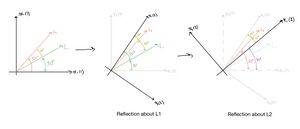Science:Math Exam Resources/Courses/MATH152/April 2022/Question A18
{{#incat:MER QGQ flag|{{#incat:MER QGH flag|{{#incat:MER QGS flag|}}}}}}
• QA01 • QA02 • QA03 • QA04 • QA05 • QA06 • QA07 • QA08 • QA09 • QA10 • QA11 • QA12 • QA13 • QA14 • QA15 • QA16 • QA17 • QA18 • QA19 • QA20 • QB1 (a) • QB1 (b) • QB2 (a) • QB2 (b) • QB2 (c) • QB3 (a) • QB3 (b) • QB4 (a) • QB4 (b) • QB4 (c) • QB5 (a) • QB5 (b) • QB5 (c) •
Question A18 |
|---|
|
Let be the reflection of the plane across the line that makes an angle with the positive -axis. The composition of two such reflections
is the rotation by an angle . Find this . |
|
Make sure you understand the problem fully: What is the question asking you to do? Are there specific conditions or constraints that you should take note of? How will you know if your answer is correct from your work only? Can you rephrase the question in your own words in a way that makes sense to you? |
|
If you are stuck, check the hints below. Read the first one and consider it for a while. Does it give you a new idea on how to approach the problem? If so, try it! If after a while you are still stuck, go for the next hint. |
Hint 1 |
|---|
|
Draw a picture of what these reflections represent. What does the picture look like when you apply the second reflection to the result of the first reflection? |
Hint 2 |
|---|
|
Here is a hack that allows for a quick solution just in this case. The question statement already tells us that the composite is a rotation, so we just need to compute what it does to a single vector, for example a unit vector that is fixed by . |
|
Checking a solution serves two purposes: helping you if, after having used all the hints, you still are stuck on the problem; or if you have solved the problem and would like to check your work.
|
Solution 2 |
|---|
|
We will follow the second hint. Let be a vector that makes an angle of with the -axis. Then the first reflection fixes , so the composite takes into , which is a vector that makes an angle of 40º with , in the counterclock-wise direction. Therefore, is equal to rotation by 40º. |
{{#incat:MER CT flag||
}}






























